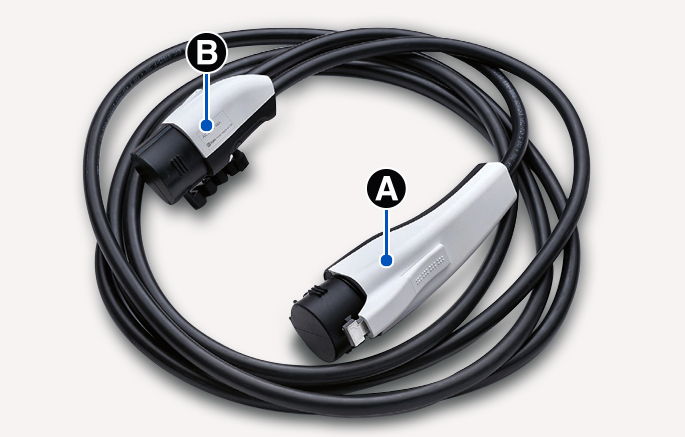Using an AC charger
AC charging is the most common charging method for electric vehicles. Charge your electric vehicle using an AC charging cable installed in public charging stations or separately purchased AC charging cable.
Before charging the vehicle, carefully read and follow the instructions in "Safety precautions for charging your electric vehicle" to prevent property damage or injury due to electric shock, fire, explosion, etc.
To prevent property damage or injury due to fire or explosion, follow the instructions below.
-
Only use the genuine AC charging cable provided by the manufacturer (if equipped).
-
Do not use an extension cable.
-
Check the rated voltage and maximum charging current required for charging, and ensure that the charger power you are using meets the requirements.
-
Immediately stop charging if you discover abnormal conditions, such as odor or smoke.
The exterior and configuration of the AC charging cable are as follows:

2C_ACCharger
- Charging connector (Vehicle side)
- Charging plug (Charger side)
Follow the instructions below to charge the vehicle with an AC charger.
-
With the vehicle started, apply the Electronic Parking Brake (EPB) while pressing the brake pedal.
-
Turn all switches off, shift to P (Park), and turn off the vehicle.
-
With the door unlocked, open the charging door by pressing the sign of opening.
-
Open the charging inlet cover and check the charging connector and charging inlet for dust or other contaminants.
-
If there is any dirt or contaminants, remove it using the air gun.
Do not touch the charging connector of the charging cable or the charging inlet on the vehicle.
-
-
Remove the charging connector protection cap of the AC charging cable, hold the charging connector handle, and connect it to the AC charging inlet on the vehicle. Push it until you hear a click.
-
[If using separately purchased charging cable] Remove the charging plug protection cap of the AC charging cable, hold the charging plug handle, and connect it to the electric outlet (220 V/230 V) of the AC charger.
-
This process is required only when using a separately purchased AC charging cable. If you use a charging cable installed in an AC charger, a separate charging plug connection is not required.
-
When scheduled charging is set, "Waiting to charge at scheduled time" is displayed.
-
When scheduled air conditioner or heater operates while waiting for the scheduled charging, the estimated charging time is displayed as "-."
-
-
[If using a separately purchased charging cable] When charging is complete, hold the charging plug handle, disconnect the charging plug from the electric outlet (220 V/230 V) of the AC charger, and close the protection cap of the charging plug.
-
This process is required only when using an AC charging cable purchased separately. If you use a charging cable installed in an AC charger, a separate charging plug disconnection is not required.
-
-
Hold the charging connector handle, and pull the charging connector to disconnect it from the charging inlet.
Do not forcibly disconnect the charging connector without pressing the unlock button on the charging connector. It may damage the charging connector or the charging inlet on the vehicle.
-
Close the charging inlet cover and press the charging door to completely close it.
-
If the charging connector locking mode is set to Always or While charging, unlock the door by pressing the button on the smart key or the button on the driver's door, and disconnect the charging connector from the charging inlet.
-
For more information, refer to the "Setting charging connector locking mode" section in this chapter.
-
-
During AC charging, the quality of radio reception may degrade in some areas.
-